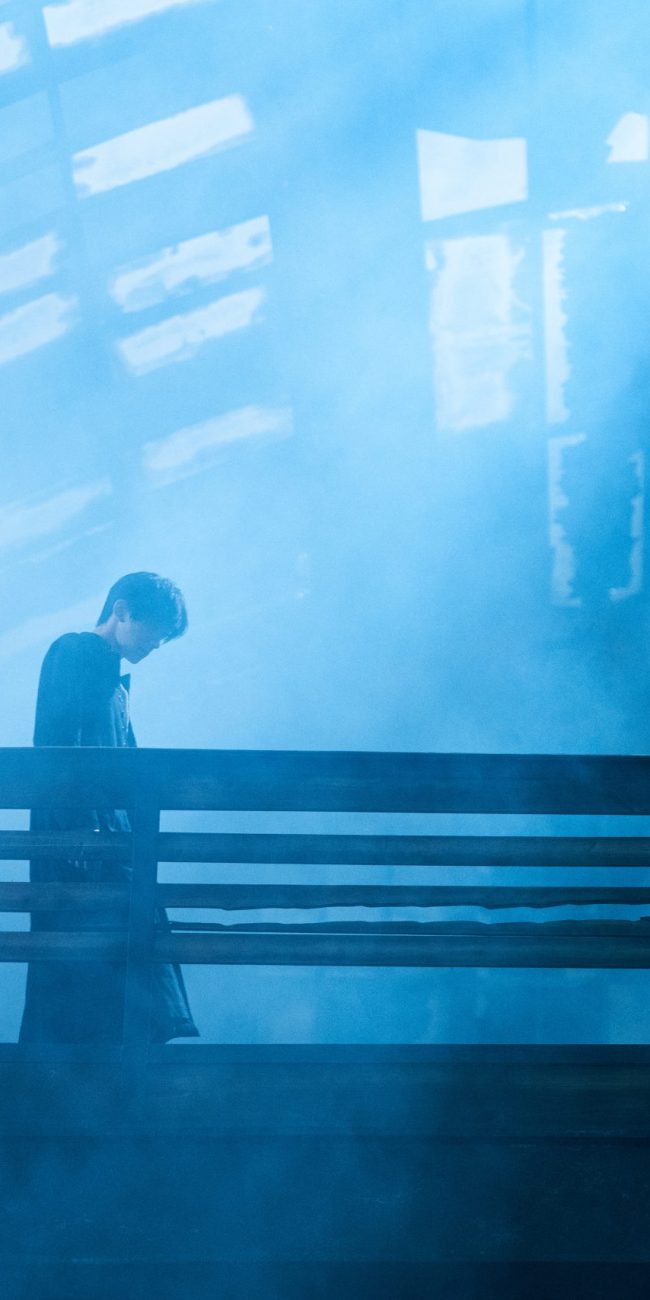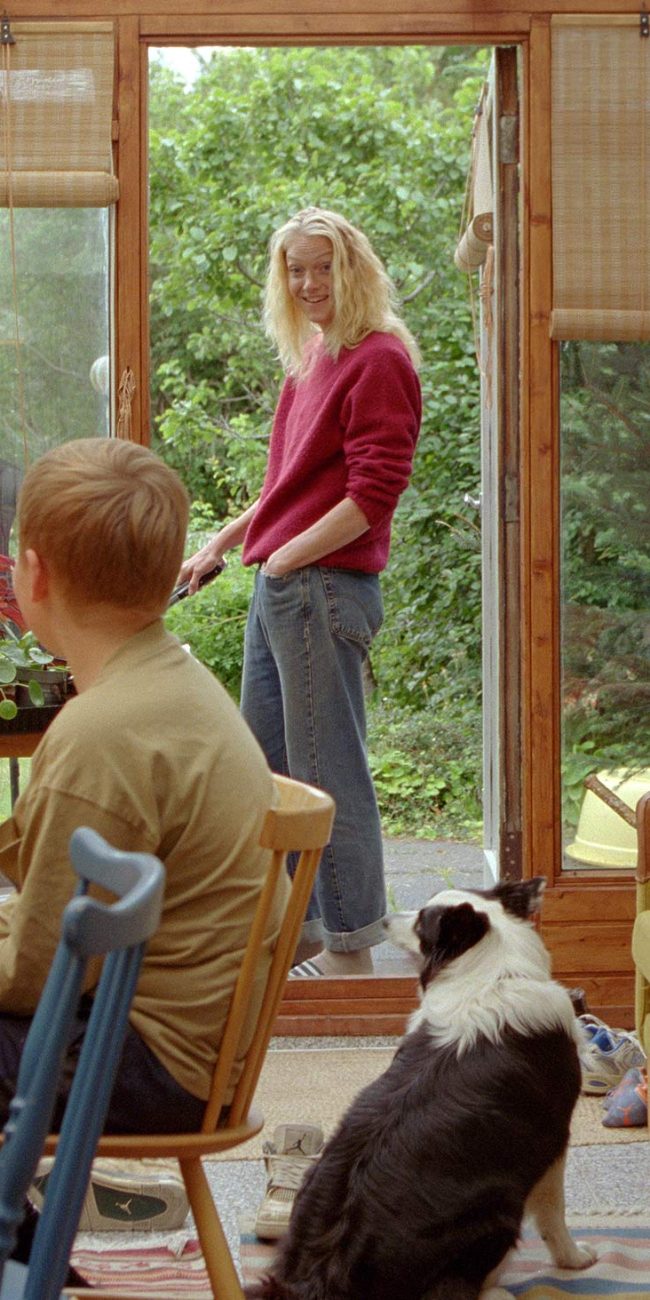A Conversation with Ira Sachs (PETER HUJAR’S DAY)
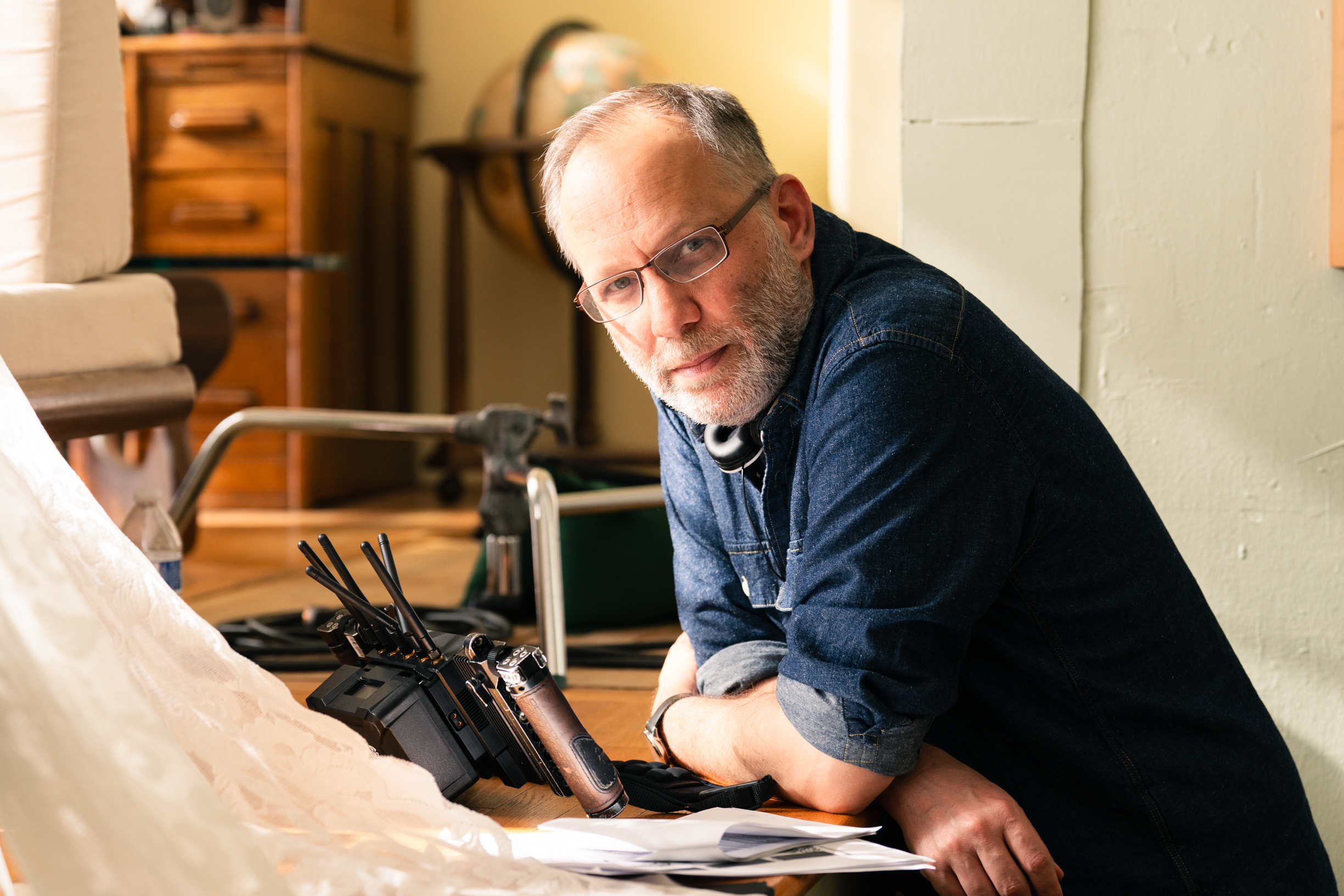
Ira Sachs returns with Peter Hujar’s Day, a mesmerizing 76-minute chamber piece that transforms a rediscovered 1974 transcript into an intimate portrait of friendship, artistry, and 1970s New York bohemia. The film reunites Sachs with Ben Whishaw, star of his acclaimed 2023 feature Passages, casting him as legendary photographer Peter Hujar alongside Rebecca Hall as writer Linda Rosenkrantz. Based on Rosenkrantz’s 2021 book, which reproduced a newly discovered audio transcript of Hujar recounting his previous day in exhaustive detail, Sachs, working with cinematographer Alex Ashe, Production designer Stephen Phelps, Art Director Ryan Scott Fitzgerald and his regular editor Affonso Gonçalves, creates something expansive and cinematic from this static setup. Shot on 16mm at Westbeth Artists Housing in Manhattan’s West Village, the film gets so much out of a single apartment, using light, space, and the shifting dynamics between the actors to create an unexpectedly moving meditation on memory, observation, and the details that make up an artist’s life. Peter Hujar’s Day is a formally audacious work that captures both the creative ferment of 1970s downtown New York and the enduring power of friendship. The film premiered at Sundance 2025, however, I saw it gloriously presented at the Alice Tully Hall for NYFF. It opened in theaters via Janus Films on November 7th.
Hammer to Nail: It’s great to speak again. We spoke for Passages as well. I loved this movie so much both times I saw it. While this is definitely a dialogue-driven film in many ways, as it’s just two people talking for 70 minutes, I found myself absolutely enamored by the production design. So I’d love to hear about your collaboration with Stephen Phelps and Ryan Scott Fitzgerald and how that all worked.
Ira Sachs: I think the challenge of the film was to confront its stasis. Once I started working on it, I realized that I needed to do it non-realistically. In all likelihood, Peter and Linda sat at a table and talked for an hour and a half and probably didn’t move very much. But when I started to try to block the film in a realistic way, I realized that it was not a movie. That was something else.
Through really a kind of intimate dialogue I had with a number of films made in the ’70s and ’60s that were these personal portraits,films like Portrait of Jason by Shirley Clarke or My Girlfriend’s Wedding, a film by Jim McBride, I began to get a key to how to open the film up. What might have been stagnant became, in fact, a film set in about 20 different locations, all within one apartment. Part of what Stephen and Ryan and I did was really consider each space its own visual landscape. There is certainly continuity, but there is also a kind of freedom. The use of wallpaper and corners and practical lighting gave these spaces each an emotional texture that becomes part of the film.
One of the interesting things I found is that in deciding which part of the movie was going to be shot in what location, at what time of day, it was all random. I didn’t say, “Oh, I want them to talk about this at that place.” It would be like, now is the time to cut, so they’re going to be talking about whatever is next in this location. That location, based on light, darkness and physical proximity, changed the way they talked about that certain thing, just as a Zoom screen will change the way you and I talk. There was almost like a John Cage experiment going on here, which had to do with something very random.
We were also very fortunate to have a lot of material from Linda about her apartment and where she lived. We didn’t hold to it in any sense of accuracy, but there were certain things like spider plants and certain kinds of macrame art and mid-century couches and the candelabra on a table with a tablecloth. These were clues that came from these original photographs.
HTN: You and Linda have developed a friendship throughout this production. What did she teach you about Peter that you couldn’t have gleaned from just that transcript?
IS: I think Peter becomes visible to me through his words and Ben’s performance. What I learned is this combination of what Linda brought to the movie and also what Rebecca brings to the film, which is the depth of affection and love that Linda, the character Linda, shows for the character of Peter. I actually think that depth is authentic and is something Rebecca picked up from talking to Linda. She tells the story of really a kind of romantic friendship that I find one of the more special elements of the film.
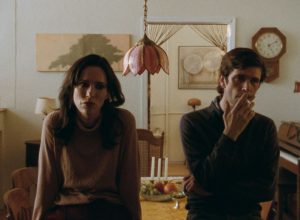
Rebecca Hall and Ben Wishaw in PETER HUJAR’S DAY
HTN: You spent six weeks with cinematographer Alex Ashe creating a storyboard using photographs. Can you discuss that collaboration with Alex? Is storyboarding always an essential part of your pre-production process? And why did you guys choose to shoot on 16MM?
IS: I couldn’t approach a movie without spending a lot of time with a cinematographer and often a storyboard artist to try to do the kind of long, circular work that it takes for me to figure out what are the shots. It doesn’t happen on set when you’re under a certain kind of pressure. You can’t really drink coffee and watch things and talk and go backwards and forwards. The collaborative process with the cinematographer is, for me, equal to the writing of the film. It’s a form of writing that I do.
In this case, Alex and I spent a number of days on location that was already designed and built and lived, thanks to Stephen Phelps & Ryan Scott Fitzgerald. We shot stand-ins for Ben and Rebecca at different times of day and in different spaces. Ultimately, those photographs, a series of images, began to speak back to me and say, “This is the film, this is the story.” Then it was a process of constructing a shooting schedule that mirrored what we needed, which meant we need to be in this space at 6 p.m. because the sun will set in this way. We need to be outside at 2 in the afternoon because we want the light of midday in New York City. There was this configuring all about light and time in the production schedule of the film.
HTN: The shifting of the focus of the camera is obviously an essential part of this film. There’s a particular moment where Peter is discussing the persimmons, and the camera blurs right on Rebecca’s face and slowly shifts over to Ben, who’s now in focus. Can you talk about that moment? I thought it was very striking.
IS: I think often I work in a kind of conversation with certain images that have become part of my own imagination. That shot is a kind of interaction between myself and a shot from The Bitter Tears of Petra von Kant. The secretary in the background and Petra on the bed, Petra talking about something to another friend and the camera zooms in on the secretary, changes, shifts focus, and then moves over to Petra.
I guess I wanted the film to be both a story of a day in the life of Peter Hujar, but also it’s a reflection on the nature of photography and portraiture, and specifically cinematic portraiture. How do we look at things? How do we look at intimacy through the screen? And also, how do we take pleasure in the way that the camera can work? I needed the film to be, for me, a kind of visual action film. There’s shots in the film that mirror Godard in the ’80s. There are riffs on Pialat in a film called The Mouth Agape. I just let myself have that liberty because I was interested in the pleasures that it brought me, and the audience as well.
HTN: At the 39-minute mark, we have this amazing dance sequence to the song “Hold Me Tight” by Jim McDonald. Can you talk about what was important to you in depicting this moment?
IS: I think it’s a break. It’s a release. I needed to find ways to let the audience off the hook and also to experience the actors without words in certain kinds of movement or silence, or in this case, dance. Again, I was thinking of Fassbinder’s use of old American songs in films like Veronika Voss specifically. I heard that song on the radio driving my kids to school one day and I pulled over and I Shazamed it. Somehow I was able to find the original.
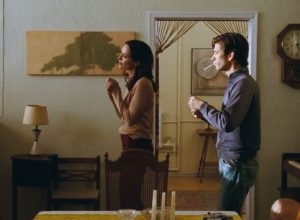
Rebecca Hall and Ben Wishaw in PETER HUJAR’S DAY
I’m always listening to songs that evoke a kind of presence and absence for the filmgoer. The song is there, but it’s also not there in a certain way, if that makes any sense. There’s a neutrality to the song that you can’t quite place. I tried to get a choreographer to help me with that. I kept thinking, “I need a choreographer. How am I going to do this?” Ultimately, I didn’t have a choreographer. What you’re seeing is Ben and Rebecca just enjoying the song. It’s a record of that as well.
HTN: I really love this conversation about Peter at the Chinese restaurant at the 42-minute mark. The description of this fat man who has a great face, looks unmarried and is 35 was also just so striking to me. Why was it important to include this moment?
IS: When I read the book and even until we started shooting and maybe until we started editing, it wasn’t clear to me how extraordinary the text is. It’s not just that Peter Hujar was given the opportunity to talk about his day, it’s his ability to do so with such detail. It’s quite magnificent. The detail was always what I loved the most. It’s what made me think that the film was ultimately quite visceral for the audience.
For me specifically, the image at the end of the film of a man in the middle of the night standing at his window overlooking 2nd Avenue and 12th Street, listening to the prostitutes on the street below him do their “shop talk”, as Linda calls it, their talk of the trade—to me, that is such a cinematic image, even if it’s just described. I tried to, at that point in the film, actually evoke the feeling of both the image and the story being told at the same time.
HTN: At the 51-minute mark, we see Linda’s first genuine concern for Peter’s behavior, accusing him of being malnourished and tired. He brushes it off. This leads into an incredibly beautiful shot of them on the roof, looking out as Peter describes the restaurant shoot and the great work he did. Can you discuss these two small but great moments?
IS: I think Linda is a caregiver, caretaker, and a friend. She’s very attentive to Peter. One thing I enjoy is how unattentive Peter is to her. That’s part of the humor of the film for me. Linda often chimes in with certain observations and Peter, as played by Ben, pays no attention, which I think is interesting. That being said, never for a moment do I sense in Rebecca’s performance anything but genuine love for Peter from Linda. She never scolds him in any way but affectionately. I find that with my relationship with Linda. She’s a very kind person, much kinder than me, and I imagine much kinder than Peter.
I tried to not think of this very consciously, but it was certainly part of my unconscious work, was a recognition that Peter would be dead 13 years later. The loss of that voice and that individual and that artist and that friendship was something that permeated my awareness as I made the film, but I wanted to try to keep that not at the front of my head, but at the back of my head, so as to not make the film a nostalgic one.
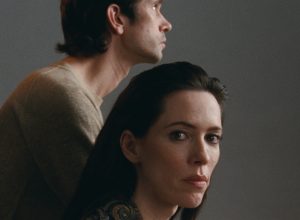
Rebecca Hall in PETER HUJAR’S DAY
HTN: Another small moment that really stopped me in my tracks was Peter’s discussion about how women’s photos of men are very charming. Particularly, he mentions the beautiful Shayla, who would turn her camera to a construction worker, for example, and find the beauty there. Can you talk about that concept? Do you think you struggle to make charming portraits of men?
IS: Every time I listen to that line, I try to listen harder to understand it, to be honest. It seems so absolute, but I’m not sure I think it’s true. I think it’s true about Shayla, and I think it’s true about her photography—she had an eye, because I’ve tracked some of that down. But I wonder how you can see gender in an eye.
I think often about Eric Rohmer and Nestor Almendros making movies together, which for me are some of the most horny films I’ve ever seen. One is a gay man, Nestor, and Eric, who seems to me purely heterosexual, but they both look at skin and young people with such carnal desire. I love to see that desire in the image. That’s what Peter is talking about. Maybe Peter feels some shame for his desire, so he’s less comfortable than he imagines Shayla would be in photographing men.
HTN: Editor Affonso Gonçalves suggested using Mozart’s Requiem in D Minor throughout the film, which is definitely a bold choice. What made you embrace that? And can you talk about that first moment it’s deployed where they stare into the camera around the 30-minute mark?
IS: I think for me, that choice turns the minor into major in a way that is, you could say, Brechtian. It’s actually drawing attention to what the film tries not to draw attention to, which is its monumentality. I think it gives a certain unexpected heft and distance to this very daily conversation. I like, in film, discovering moments that rupture the audience’s flow, that separate the audience for a moment so that when they reattach to the film, they do so in a different way. The film is musical, and it needs highs and lows, and it needs lightness and gravity. I think the Requiem gives the film gravity. It also is a bit campy, to be honest. There’s a camp quality to that seriousness.
HTN: Well, Ira, that’s all the time I have. It was so great to sit with you and pick your brain again. This was definitely one of my favorite movies of the year. I’ll be telling all my friends to go see it. Thank you so much for taking the time to speak with me.
IS: Thank you.
Peter Hujar’s Day opened in theaters November 7th via Janus Films.
– Jack Schenker (@YUNGOCUPOTIS)








